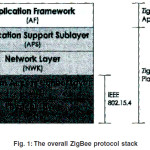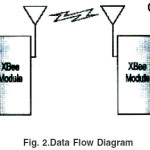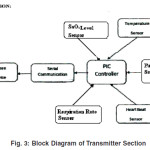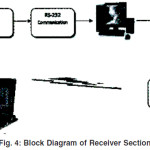Wireless Sensor Network for Monitoring A Patient Having Hole in the Heart Continuously Using Zigbee
P. Ramanathan¹ and Pradip Manjrekar²
¹ECE-DEPT Pallavan College of Engineering, Thimmasamudram, Kanchipuram - 631 501 (India).
²Flat No.248, CGS colony, near wadala R.S. Post Office, Wadala (west), Mumbai (India).
Article Publishing History
Article Received on :
Article Accepted on :
Article Published :
Article Metrics
ABSTRACT:
In this research paper, we presented the wireless Sensor network (WSN)for monitoring a patient having hole in the heart continuously using ZIGBEE The output of biosensor has to be transmitted via Zigbee and the same has to be sent to the remote wireless monitor for observing the condition of the patient having hole in the heart and for the same proper medical treatment should be given to him/ her without surgery using alternative medicine to cure hole in the heart. The remote wireless monitor is constructed of Zigbee and personal computer (PC). The measured signal has to be sent to the PC, which can be data collection. When the measured signals over the standard value, the personal computer sends Global system for Mobile communication (GSM) short message to the care taker. Although Bluetooth is better than Zigbee for transmission rate, but Zigbee has lower power consumption. Hence, Zigbee is generally used for 24 hours monitor of communication transmission system. The first procedure of the system that we use the biosensor to measure Heart rate and blood pressure from human body using Zigbee the measured signal sends to the PC via the RS-232 serial port communication interface. We can send the signal to remote PC or PDA from the internet. In particular, when measured signals over the standard value, the personal computer will send GSM short message to absent care taker’s mobile phone.
KEYWORDS:
Physical-sensor; Zigbee; Relays; Voice Board; Low voltage power amplifier; Power supply; RS232 serial communication; Max 232; Timers; ADC module
Copy the following to cite this article:
Ramanathan P, Manjrekar P. Wireless Sensor Network for Monitoring A Patient Having Hole in the Heart Continuously Using Zigbee. Orient. J. Comp. Sci. and Technol;4(1)
|
Copy the following to cite this URL:
Ramanathan P, Manjrekar P. Wireless Sensor Network for Monitoring A Patient Having Hole in the Heart Continuously Using Zigbee. Orient. J. Comp. Sci. and Technol;4(1). Available from: http://www.computerscijournal.org/?p=2391
|
Introduction
A small defect between the two upper chambers of the heart recently has been linked to stroke and appears to be linked migraine headaches. The defect is known as a patent foramen ovals(PFO), now can be detected and treated without surgery. The foramen ovals is an opening between the right and left atrium (atrial septum). This opening allows blood to flow between the atria in babies before birth. Most of the time, this hole closes at or just after birth. If it does not close, this hole is called a patent foramen ovals, or PFO. Because the PFO exists, it may allow blood or other debris to cross from the right to the left atrium.
Ways to diagnose PFOs
- Electrocardiogram
- Chest X-ray
- Echocardiogram
- Doppler ultrasound
- Tran esophageal echocardiography
- Cardiac magnetic resonance imaging(MRI)
- Cardiac catheterization
- Angiography
After confirming that a patient is having a hole in the heart he/she should be monitored continuously using wireless communication network and for the same proper medical treatment should be given to him/her without surgery using alternative medicine to cure hole in the heart.
In the current Hi Tech, wireless communication place the major role which led us the innovative idea of using this new technology for many applications.
A wireless sensor network (WSN) is a wireless network consisting of spatially distributed autonomous devices using sensors to monitor physical conditions. The development of wireless sensor networks was originally motivated by military application such as battlefield surveillance.
After around a decade of active research on wireless sensor network recent standards released are stimulating the development of commercial products. One of standards is zigbee. This paper highlights some of the lessons from the field that went into the standard. It also describes the ecosystems emerging around zigbee and the enabling trends in that ecosystem. New area of activity in the zigbee standards body is highlighted as well.
The researcher concentrated on his research to apply this WSN using zigbee for monitoring a patient having hole in the heart continuously using ZIGBEE and succeeded the same.
The researcher first chose the proper sensor for the above application to convert the physiological signals into electrical signal which is in the form of analog signal. This analog signal was converted into digital signal by designing a proper circuit. This digital signal was fed into the PIC controller. The output of this PIC controller is fed into the serial communication circuit. The output of this serial communication circuit is fed into the zigbee device and output of this zigbee device is transmitted via transmitting antenna. In the receiver side the said transmitted signal is received through the receiving antenna and fed into the zigbee unit. The output of this zigbee unit is fed into the RS-232 serial port communication interface and output of this RS-232 is fed into personal computer (PC) sends global system for mobile communication (GSM) short message to the receiver. The receiver can use the PC or personal digital assistant (PDA) to observe the sensed signals in the remote place.
The PIC microcontrollers are supported with a full range of hardware and software development tools. The researcher found the transmission section codes using various to operate the transmission of sensed digital signals. To operate the received signals using various the researchers found the same.
From the above it is very clear that the researcher designed not only circuits for the above applications but required software’s to operate the above projects and to get the good result outputs.
Methodlogy
The name ZigBee is said to come from the domestic honey bee which uses a zig-zag type of dance to communicate important information to other members. This communication dance is what engineers are trying to emulate with this protocol a bunch of separate and simple organisms that join together to take complex tasks.
The Zigbee protocol is implemented on top of the IEEE 802.15.4 radio communication standard. The Zigbee specification is managed by a non-profit industry consortium of semiconductor manufactures, technology providers and other companies, all together designated the Zigbee alliance. The alliance currently numbers more than 150 members.
The Zigbee specification is designed to utilize the features supported by IEEE 802.15.4. In particular, the scope of Zigbee is applications with low requirements for data transmission rates and devices with constrained energy sources.
The intended market spaces for Zigbee products include home control and building automation. Imagine the intelligent building, controlling the lighting and temperature as needed, monitoring the building structure and performing surveillance tasks with a minimum of user interaction. This is the potential of Zigbee.
Two message types are defined
- Key value pair (KVP) service which uses a standardized way of representing messages using binary XML.
- Message (MSG) service which gives full control over the messages being sent for application-specific needs.
Data Flow Diagram
The ZigBee/Zigbee-PRO OEM RF Modules interface to a host device through a logic-level asynchronous serial port. Through its serial port, the module can communicate with any logic and voltage compatible UART; or through a level translator to any serial.
Today, organizations use Zigbee to effectively deliver solutions for a variety of areas. With this comprehensive set of attributes, the nonprofit, open membership and the volunteer-driven alliance has become a thriving ecosystem of more than 300 members. As an ecosystem, the alliance offers everything prospective product and service companies need to develop Zigbee products and services and benefit from the alliance’s competitive and stable supply chain.
Zigbee is provided with lower consumption, small volume, high expansion, stylization and two-way transmission, etc.
The health care domain presents opportunities for a significant number of applications of wireless sensor technology. The following sections focus on broad health monitoring applications that include chronic disease monitoring, personal wellness monitoring, and personal fitness. Within each of these applications, we describe several specific uses of wireless sensor technology.
As shown in the figure below, the researcher first chose the proper sensor for the above applications to convert the physiological signal into electrical signal which is in the form of analog signal. He converted this analog signal into digital signal by designing a proper circuit. This digital signal was fed into the PIC controller. The output of this PIC controller is fed into the serial communication circuit. The output of this serial communication circuit is fed into the Zigbee device and output of this Zigbee device is transmitted via transmitting antenna.
As shown in the under mentioned figure in the receiver side the said transmitted signal is received through the receiving antenna and fed into the Zigbee unit. The output of this Zigbee unit is fed into the RS-232 serial port communication interface and output of this RS-232 is fed into personal computer (PC) which can be data collection. This personal computer (PC) sends global system for mobile communication (GSM) short message to the receiver. The receiver can use the PC or personal digital assistant (PDA) to observe the sensed signals in the remote place.
Result
In the research, 3 persons were made to undergo the test. Person A is in the age group of 1-10 years. Person B is in the age group of 11-30 years. Person C is in the age group of 31-80 years old
Firstly, we had taken pulse rate measurements for the persons A, B and C. When an abnormality is observed and the pulse drop is below the predetermined level then a call is dialed to the doctor and residence indicating the critical condition of the patient. Hence the numbers were dialed successfully to the doctor.
Therefore, research is successful. Also sensed signals were observed through personal computer (PC) or personal digital assistant (PDA). Hence the research is successful.
Secondly, we tested heart rate for persons A, B and C. When the heart rate crosses 72 beats per second and when it is lower then 72 beats per second, the condition was identified as abnormal. Hence in such a situation automatically a call is dialed to the doctor, nearby hospital and to the residence. Hence the research was successful. Also sensed signals were observed through personal computer (PC) or personal digital assistant (PDA). Hence, research is successful.
Table 1: Comparison of wireless technologies
|
|
Zigbee
|
Bluetooth
|
Wi-Fi
|
|
Standard
|
802.15.4
|
802.15.1
|
802.11b
|
|
Memory
|
4-32KB
|
250KB+
|
1MB+
|
|
requirements
|
Years
|
Days
|
Hours
|
|
Battery
|
65000+
|
7
|
32
|
|
Nodes per master
|
250Kb/s
|
1Mb/s
|
11Mb/s
|
|
Data rate Range
|
300m
|
10m
|
100m
|
- Next, persons A, B and C were tested for respiration rate measurement. Respiration rates above the normal level or below the normal level (when at rest) may be considered abnormal. In such a situation automatically a call is dialed to the doctor, near by hospital and to the residence. Hence our research was successful. Also sensed signals were observed through personal computer (PC) or personal digital assistant (PDA). There fore research is successful.
- Next, we had taken temperature measurement for the persons A, B and C. While the temperature goes below the normal condition or above the normal condition, LED (yellow) glows and automatically a call is dialed to the doctor near by hospital and to the residence who have given their phone or cell number indicating that the patient is in abnormal condition. Hence the research is successful.
- Also sensed signals were observed through personal computer (PC) or personal digital assistant (PDA). Hence research is successful.
- Persons A, B and C were tested for SaO2 level. When the ratio goes low, a call was automatically dialed to the doctor, near by hospital and to the residence. Hence the research is successful.
Conclusion
Hence, we have developed a successful research project that identifies the abnormal conditions of the persons who took the treatment.
- Regarding pulse rate measurement of the person, when there was a drop in the pulse, automatically a call was dialed to the doctor, near by hospital and also to the residence and this drop in the pulse rate was observed in the PC or PDA. Accordingly, treatment was given to cure the hole in the heart of human.
- While heart rate was checked for above and below normal level, signs of abnormal conditions were seen. In such a case a call was dialed to the doctor, near by hospital and to the residence and also this drop in the heart rate was observed in the PC or PDA. Accordingly, treatment was given to cure the hole in the heart of human.
- While respiration rate was checked for above and below normal level, signs of abnormal conditions were seen. Hence automatically a call was dialed to the doctor, near by hospital and to the residence and also this drop in the respiration rate was observed in the PC or PDA. Accordingly, treatment was given to cure the hole in the heart of human.
- Temperature measurement was taken for above and below the normal level. When the body temperature cross the normal level, automatically a call was dialed to the doctor, nearby hospital and to the residence and also this drop in the temperature was observed in the PC or PDA. Accordingly, treatment was given to cure the hole in the heart of a human.
- When oxygen level in the blood was checked and was found low, automatically a call was dialed to the doctor, nearby hospital and to the residence and accordingly, treatment was given to cure the hole in the heart of human.
Hence, the researcher developed a successful research project to monitor the patient continuously through a wireless link. An intermediate person is not required to update and inform the condition of the patient to the doctor and the residents. Thus, this wireless sensor network using ZigBee will be very useful to the human civilization and will be Revolutionary research and development in a medical field.
Based on the monitoring results, proper medical treatment should be given to the patient who posses hole in his/her heart without surgery using alternative medicine to cure this hole in the heart
We believe that there is definitely a place on the market for ZigBee since no global standard exists today in the wireless sensor network area. Two fully functional ZigBee//802.15.4 modules have been developed. It is possible to design a module with RF parts on a low-cost FR-4 PCB substrate. By using a four layer PCB the size is reduced significantly.
References
- Safaric S.Malaric K., “ZigBee wireless standard’’, multimedia signal processing and communications, 48th international symposium ELMAR 2006, Zadar, Croatia, June (2006).
- Ze Zhao and Li Cui “EasiMed: A remote health care solution”, proceeding of the 2005 IEEE Engineering in medicine and Biology 27th annual conference, Shanghai, China, September (2005).
- David Gay, Philip Levis, David Culler and Eric Brewer. NesC1.1 Language Reference Manual, May (2003).
- Chiechi MA, Less WM, Thomson R. Functional anatomy of mitral valve.1 J Thorac Surg 6: 825-31 (1956).
- Wilcox BR, Anderson RH. Surgical anatomy of the heart.

This work is licensed under a Creative Commons Attribution 4.0 International License.




